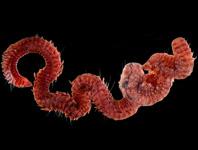Abstract
Two new species of Lithoxus, a genus diagnosed by possessing a dorsoventrally depressed body, a large round oral disk, and small tooth cusps with few teeth, are described from two drainages of the Guiana Shield: Lithoxus jariensis from the rio Jari basin and L. raso from the rio Raso, rio Amapá basin. The new species, L. jariensis, is distinguished from congeners by having an adipose fin, by the number of branched anal-fin and caudal-fin rays, by color pattern of the body, number of teeth, adipose-fin length, dorsal adipose-caudal distance, caudal peduncle depth, cleithral width, and dorsal-anal distance. Lithoxus raso can be diagnosed from congeners by coloration pattern, by having an adipose fin, by the number of branched anal-fin rays, number of teeth, adipose-fin length, dorsal adipose–caudal distance, caudal peduncle depth, and cleithral width. Greater genetic divergence in mitochondrial cytochrome oxidase subunit I (COI) confirms L. jariensis and L. raso as two new species.
References
Armbruster, J.W. (2003) Peckoltia sabaji, a new species from the Guiana Shield (Siluriformes, Loricariidae). Zootaxa, 344, 1–12.
https://doi.org/10.11646/zootaxa.344.1.1Armbruster, J.W. (2004) Phylogenetic relationships of the suckermouth armoured catfishes (Loricariidae) with emphasis on the Hypostominae and the Ancistrinae. Zoological Journal of the Linnean Society, 141, 1–80.
https://doi.org/10.1111/j.1096-3642.2004.00109.xBoeseman, M. (1982) The South American mailed catfish genus Lithoxus Eigenmann, 1910, with the description of three new species from Surinam and French Guyana and records of related species (Siluriformes, Loricariidae). Proceedings of the Koninklijke Nederlandse Akademie van Wetenschappen, Series C, Biological and Medical Sciences, 85, 41–58.
Edgar, R.C. (2004) MUSCLE: Multiple sequence alignment with high accuracy and high throughput. Nucleic Acids Research, 32, 1792–1797.
https://doi.org/10.1093/nar/gkh340Eigenmann, C.H. (1910) Catalogue of the fresh-water fishes of tropical and south temperate America. Report Princeton University Expeditions to Patagonia, 1896–1899. Vol. 3. Indiana University, Bloomington, 137 pp. [pp. 375–511]
Eigenmann, C.H. (1912) The freshwater fishes of British Guiana, including a study of the ecological grouping of species, and the relation of the fauna of the plateau to that of the lowlands. Memoirs of the Carnegie Museum, 5, 1–578.
https://doi.org/10.5962/bhl.part.14515Eschmeyer, W.N. & Fong, J.D. (2017) Catalog of fishes. Available from: http://researcharchive.calacademy.org/research/ichthyology/catalog/SpeciesByFamily.asp (accessed 24 May 2017)
Felsenstein, J. (1985) Confidence limits on phylogenies: an approach using the bootstrap. Evolution, 39, 783–791.
https://doi.org/10.1111/j.1558-5646.1985.tb00420.xFricke, R. & Eschmeyer, W.N. (2017) Catalog of fishes. Available from: http://researcharchive.calacademy.org/research/ichthyology/catalog/collections.asp (accessed 23 August 2017)
Garg, T.K., Valdes Domingos, F.X., Almeida-Val, V.M.F. & Val, A.L. (2010) Histochemistry and functional organization of the dorsal skin of Ancistrus dolichopterus (Siluriformes: Loricariidae). Neotropical Ichthyology, 8, 877–884.
https://doi.org/10.1590/S1679-62252010000400018Geerinckx, T., Herrel, A. & Adriens, D. (2011) Suckermouth armoured catfish resolve the paradox of simultaneous respiration and suction attachment: a kinematic study of Pterygoplichthys disjunctivus. Journal Exploration Biology, 315, 121–131.
Kearse, M., Moir, R., Wilson, A., Stones-Havas, S., Cheung, M., Sturrock, S., Buxton, S., Cooper, A., Markowitz, S., Duran, C., Thierer, T., Ashton, B., Meintjes, P. & Drummond, A. (2012) Geneious Basic: an integrated and extendable desktop software platform for the organization and analysis of sequence data. Bioinformatics, 28, 1647–1649.
https://doi.org/10.1093/bioinformatics/bts199Lujan, N.K. (2008) Description of a new Lithoxus (Siluriformes: Loricariidae) from the Guayana highlands with a discussion of Guiana Shield biogeography. Neotropical Ichthyology, 6, 413–418.
https://doi.org/10.1590/S1679-62252008000300014Lujan, N.K., Armbruster J.W., Lovejoy, N.R. & López-Fernandez, H. (2015) Multilocus molecular phylogeny of the suckermouth armored catfishes (Siluriformes: Loricariidae) with a focus on subfamily Hypostominae. Molecular Phylogenetics and Evolution, 82, 269–288.
Muller, S. & Isbrücker, I.J.H. (1993) Lithoxus boujardi (Siluriformes, Loricariidae), une espèce nouvelle du Bassin de l'Approuague, Guyane française. Cybium, 17, 71–76.
Nijssen, H. & Isbrücker, I.J.H. (1990) Lithoxus stocki, a species new to science of ancistrin loricariid catfish from the Maroni River drainage, with a comparison of the primary type specimens of the six species of Lithoxus (syn. Paralithoxus) (Pisces, Siluriformes, Loricariidae). Bijdragen tot de Dierkunde, 60, 327–333.
Regan, C.T. (1906) Notes on some loricariid fishes, with descriptions of two new species. Annals and Magazine of Natural History, Series 7, 17 (97), 94–98.
https://doi.org/10.1080/00222930608562495Tamura, K., Stecher, G., Peterson, D., Filipski, A. & Kumar, S. (2013) MEGA6: Molecular Evolutionary Genetics Analysis version 6.0. Molecular Biology and Evolution, 30, 2725–2729.
https://doi.org/10.1093/molbev/mst197Ward, R.D., Zemlak, T.S., Innes, B.H., Last, P.R. & Hebert, P.D.N. (2005) DNA barcoding Australia’s fish species Philosophical transactions of the Royal Society of London Series B. Biological Sciences, 360, 1847–1857.
https://doi.org/10.1098/rstb.2005.1716Xia, X. (2013) DAMBE5: a comprehensive software package for data analysis in molecular biology and evolution. Molecular Biology and Evolution, 30, 1720–1728.
https://doi.org/10.1093/molbev/mst064Xia, X. & Lemey, P. (2009) Assessing substitution saturation with DAMBE. In: Lemey, P., Salemi, M. & Vandamme, A.M. (Eds.), The Phylogenetic Handbook: A Practical Approach to DNA and Protein Phylogeny. Cambridge University Press, Cambridge, pp. 615–630.
https://doi.org/10.1017/CBO9780511819049.022Xia, X., Xie, Z., Salemi, M., Chen, L. & Wang, Y. (2003) An index of substitution saturation and its application. Molecular Phylogenetics and Evolution, 26, 1–7.
https://doi.org/10.1016/S1055-7903(02)00326-3

